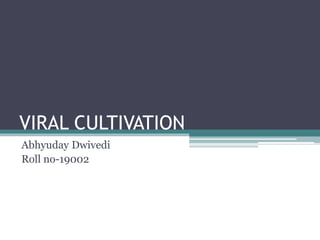Virology.pptx
Viruses can be grown through three main methods: inoculation into animals, inoculation into embryonated eggs, and tissue culture. Embryonated eggs are commonly used because they provide an ideal substrate for viral growth and replication. Viruses are inoculated into 7-12 day old chick embryos through the shell and incubated for 2-3 days, then isolated from embryo tissue. While eggs are inexpensive and easy to maintain, different viruses grow in different locations within the egg. Tissue culture involves digesting tissues and mixing individual cells with viral growth medium in flasks, providing a broad method for cultivation but requiring trained technicians. Animal inoculation allows for studying pathogenesis but is expensive and raises welfare issues.

Recommended
Recommended
More Related Content
Similar to Virology.pptx
Similar to Virology.pptx (20)
Recently uploaded
Recently uploaded (20)
Virology.pptx
- 1. VIRAL CULTIVATION Abhyuday Dwivedi Roll no-19002
- 2. Introduction • Viruses are extremely small infectious agents that invade cells of all types. • Viruses are obligate intracellular parasites so they depend on host for their survival. • They cannot be grown in non-living culture media or on agar plates alone, they must require living cells to support their replication. • Viruses have been the culprits in many human diseases, including smallpox, flu, AIDS, and the ever- present common cold as well as in plant, bacteria and archaea also.
- 3. Methods for Cultivation of Virus •Generally three methods are employed for the virus cultivation 1.Inoculation of virus into animals 2.Inoculation of virus into embryonated eggs 3.Tissue culture
- 4. 1. Animal Inoculation • Viruses which are not cultivated in embryonated egg and tissue culture are cultivated in laboratory animals such as mice, guinea pig, hamster and rabbits are used. • The selected animals should be healthy and free from any communicable diseases. • Mice (less than 48 hours old) are most commonly used. • Mice are susceptible to togavirus and coxsackie viruses which are inoculated by intracerebral and intranasal route.
- 5. Advantages Disadvantages • Diagnosis, Pathogenesis and clinical symptoms are determined. • Production of antibodies can be identified. • Primary isolation of certain viruses. • M ice provide a reliable model for studying viral replication. • Used for the study of immune responses, epidemiology and oncogenesis • Expensive and difficulties in maintenance of animals. • Difficulty in choosing of animals for particular virus • Some human viruses cannot be grown in animals , or can be grown but do not cause disease. • Mice do not provide models for vaccine development. • Issues related to animal welfare systems.
- 6. 2. Inoculation into embryonated egg • Good pasture in 1931 first used the embryonated hen's egg for the cultivation of virus. • The process of cultivation of viruses in embryonated eggs depends on the type of egg which is used. • Viruses are inoculated into chick embryo of 7-12 days old. • For inoculation, eggs are first prepared for cultivation, the shell surface is first disinfected with iodine and penetrated with a small sterile drill.
- 7. • After inoculation, the opening is sealed with gelatin or paraffin and incubated at 36°c for 2-3 days. • After incubation, the egg is broken and virus is isolated from tissue of egg. • Viral growth and multiplication in the egg embryo is indicated by the death of the embryo by embryo cell damage or by the formation of typical pocks or lesions on the egg membranes • Viruses can be cultivated in various parts of egg like chorioallantoic membrane, allantoic cavity, amniotic sac and yolk sac.
- 8. Embryonated egg has four sites for cultivation of virus • 1. Chorioallantoic membrane (CAM): Few viruses produce lesions called pocks, e.g. Vaccinia, Variola, HSV 1 and 2 • 2. Yolk sac: Arboviruses (e.g. JEV, Saint Louis and West Nile virus), Rickettsia, Chlamydia and Hemophilus ducreyi. • 3. Amniotic membrane: Influenza culture (for diagnosis) • 4. Allantoic cavity: Used for vaccine preparation for Influenza, Yellow fever (17D), Rabies (Flury).
- 9. Advantages Disadvantages • Widely used method for the isolation of virus and growth. • Ideal substrate for the viral growth and replication. • Isolation and cultivation of many avian and few mammalian viruses. • Cost effective and maintenance is much easier. • Less labor is needed. • The embryonated eggs are readily available. • They are free from contaminating bacteria and many viruses. • Widely used method to grow virus for some vaccine production. • The site of inoculation varies with different viruses. That is, each virus has different site for growth and replication. • This is very inconvenient.
- 10. 3. Tissue Culture • Cultivation of tissue or organ for the growth of viruses • • Organ culture: Whole organ is used, tracheal ring used for coronaviruses • • Explant culture: Minced organ is used, e.g. adenoid explant used for Adenovirus • • Cell Line: Tissues are completely digested and the individual cells are mixed with viral growth medium and dispensed in tissue culture flask.
- 11. Advantages Disadvantages • Relative ease. • Broad Spectrum • Cheaper • More Sensitive. • The process requires trained technicians with experience in working on a full time basis. • State health laboratories and hospital laboratories do not isolate and identify viruses in clinical work. • Tissue or serum for analysis is sent to central laboratories to identify virus.
- 12. Thank You